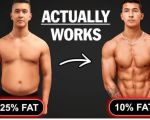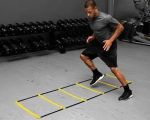
- why-hip-strength-matters-in-fitness - Why Hip Strength Matters in Fitness
- key-muscle-groups-involved-in-hip-strength - Key Muscle Groups Involved in Hip Strength
- best-gym-workouts-for-hip-strength - Best Gym Workouts for Hip Strength
- case-study-from-injury-to-performance - Case Study: From Injury to Performance
- programming-and-progression-tips - Programming and Progression Tips
- build-hip-strength-with-fitness - Build Hip Strength with Fitness
1. Why Hip Strength Matters in Fitness
When we think about building strength in the gym, hips often get overlooked. But strong hips are foundational to nearly every athletic movement—sprinting, squatting, jumping, even walking. Weak hips can contribute to poor posture, back pain, knee injuries, and reduced performance in both strength and cardio workouts. That’s why focusing on gym workouts for improving hip strength isn’t just about aesthetics—it's about stability, mobility, and longevity.
2. Key Muscle Groups Involved in Hip Strength
2.1 Gluteus Maximus, Medius, and Minimus
These three glute muscles form the engine of hip power. The gluteus maximus supports explosive strength (like in squats and lunges), while the medius and minimus are essential for stability and lateral movement. Weak glutes often lead to compensation by the lower back and hamstrings, creating imbalances that can cause injuries over time.
2.2 Hip Flexors and Extensors
Hip flexors (like the iliopsoas) help you lift your legs, while extensors (like the hamstrings) assist in hip thrust and drive. A gym routine that develops both sets of muscles evenly contributes to balanced strength and reduces the risk of strains—especially for runners or people with desk jobs who sit for long hours.
2.3 Adductors and Abductors
These muscles are crucial for movements involving side-to-side stability. Many hip-related injuries in sports come from neglecting these groups. That’s why it’s vital to integrate targeted workouts in your gym routine that address these lesser-trained but essential muscles.
3. Best Gym Workouts for Hip Strength
3.1 Barbell Hip Thrusts
A powerhouse move for glute activation, hip thrusts isolate and strengthen the hip extensors. With proper form, this exercise builds explosive hip power useful in athletic performance and helps correct glute amnesia caused by prolonged sitting. Start light and gradually increase resistance as your control improves.
3.2 Bulgarian Split Squats
This unilateral movement not only builds hip strength but also improves balance and core stability. It targets both the glutes and hip flexors and is highly effective for correcting muscular imbalances between legs. Many athletes use it to improve single-leg drive and joint alignment.
3.3 Cable Hip Abductions and Adductions
Using the cable machine, isolate the hip abductors and adductors with controlled reps. These are especially useful for enhancing lateral movement control, which is critical in sports like soccer, basketball, and skiing. They also support injury prevention by strengthening the stabilizers.
3.4 Romanian Deadlifts (RDLs)
RDLs focus on the posterior chain, especially the glutes and hamstrings. Because the movement stretches the hips through a controlled hinge, it's excellent for improving hip flexibility and power. This is a go-to for athletes looking to build explosive acceleration or improve deadlift mechanics.
3.5 Kettlebell Swings
This dynamic exercise combines cardio and strength, reinforcing hip drive and glute engagement. A proper kettlebell swing is a lesson in efficient hip hinge mechanics and has carry-over benefits to almost every other gym movement. Perfect for functional training routines.
4. Case Study: From Injury to Performance
4.1 Meet Alex: The Runner with Chronic Knee Pain
Alex, a 31-year-old amateur marathoner, struggled with chronic knee pain that derailed his training. After a movement assessment, his physical therapist pinpointed weak hips as the root cause. A 12-week gym program focused on barbell hip thrusts, RDLs, and cable abductions corrected his muscle imbalances. Not only did the pain vanish, but his pace improved by 20 seconds per kilometer.
4.2 How Targeted Training Made the Difference
What made Alex’s transformation successful was not random gym work, but a structured program targeting his hip deficiencies. His story is a reminder that sometimes performance plateaus or injuries aren’t due to overtraining—but under-training the right muscles.
5. Programming and Progression Tips
5.1 Start with Activation Before Load
Before jumping into heavy squats or deadlifts, activate your glutes with resistance band walks, glute bridges, or bodyweight lunges. This primes the hips and ensures you're not relying on your lower back or quads to compensate.
5.2 Follow a Weekly Split
Integrate hip-specific exercises at least twice a week. For example, one session can be strength-based (RDLs, hip thrusts), and the other stability-focused (cable abductions, split squats). Pairing these with core training multiplies the benefits by reinforcing trunk and hip coordination.
5.3 Progress Gradually and Track Movement Quality
Don’t chase numbers too soon. Focus on proper alignment, controlled eccentric movements, and range of motion. Tracking how your hips feel—tight, tired, or balanced—can guide how you progress your load or modify exercises over time.
6. Build Hip Strength with Fitness
Whether you're a runner, lifter, or just someone who wants to move pain-free, gym workouts for improving hip strength should be a core part of your fitness routine. Strong hips unlock better posture, smoother movement, and higher performance in every area of life. At Fitness, we provide personalized workout plans, expert guidance, and the best equipment to help you target and strengthen your hips effectively and safely.
Your journey to stronger hips starts with action. Come to Fitness to find tailored solutions that meet your goals and help you move better, longer, and stronger.








